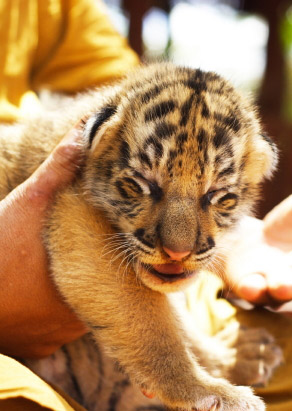 |
 |
 Tiger
cubs are irresistible and wolves are majestic. While it may seem
appealing to keep a wild animal as a pet, it's important to remember
that doing so can lead to a host of problems, not to mention legal and
ethical issues. Keeping wild animals as pets requires a great deal of
thought, research, and preparation. In addition to the ethical and
legal factors, you need to make sure you're able to provide ideal
housing and diet, as well as medical care – all of which may be
difficult to find. Tiger
cubs are irresistible and wolves are majestic. While it may seem
appealing to keep a wild animal as a pet, it's important to remember
that doing so can lead to a host of problems, not to mention legal and
ethical issues. Keeping wild animals as pets requires a great deal of
thought, research, and preparation. In addition to the ethical and
legal factors, you need to make sure you're able to provide ideal
housing and diet, as well as medical care – all of which may be
difficult to find.
Ethical and Animal Welfare Issues
Before
you attach yourself to the idea of bringing home an exotic animal,
consider the ethical issues involved, particularly those pertaining to
the welfare of the animal itself. Are you able to provide the same
quality of life in captivity that the animal would have in the wild?
Before you move forward, carefully consider whether the animal is
better off in captivity or in the wild.
Legal Issues
Research
state laws pertaining to the keeping of wild animals as pets – just
because you can acquire a wolf or a tiger cub doesn't mean it’s legal.
Check city or county laws, as well as laws at the state/provincial and
federal levels. If you break the law and are turned in or discovered,
your pet will likely be taken away.
Behavioral Issues
Especially
once they're physically mature, wild animals often become very
difficult pets. They can be aggressive and even dangerous, simply
because of their size, physical strength, and natural instincts.
Animals in captivity can also become frustrated with space limitations
and not being able to fully exhibit their natural proclivities.
Providing
proper care for a wild animal for the duration of its lifespan can be
challenging, costly, and time consuming. And what if, for whatever
reason, you're no longer able to care for the animal? Finding a good
home for an adult wild animal can be extremely difficult.
As you
can see, taking on a wild animal as a pet is not an endeavor to be
taken lightly, so take the time to do your homework before you commit.
Tiger cubs are irresistible
and wolves are majestic. While it may seem appealing to keep a wild animal as a
pet, it's important to remember that doing so can lead to a host of problems,
not to mention legal and ethical issues. Keeping wild animals as pets requires
a great deal of thought, research, and preparation. In addition to the ethical
and legal factors, you need to make sure you're able to provide ideal housing
and diet, as well as medical care – all of which may be difficult to find.
Ethical and Animal Welfare Issues
Before you attach yourself to the idea of bringing home an exotic animal,
consider the ethical issues involved, particularly those pertaining to the
welfare of the animal itself. Are you able to provide the same quality of life
in captivity that the animal would have in the wild? Before you move forward,
carefully consider whether the animal is better off in captivity or in the
wild.
Legal Issues
Research state laws pertaining to the keeping of wild animals as pets – just because
you can acquire a wolf or a tiger cub doesn't mean it’s legal. Check city or
county laws, as well as laws at the state/provincial and federal levels. If you
break the law and are turned in or discovered, your pet will likely be taken
away.
Behavioral Issues
Especially once they're physically mature, wild animals often become very
difficult pets. They can be aggressive and even dangerous, simply because of
their size, physical strength, and natural instincts. Animals in captivity can
also become frustrated with space limitations and not being able to fully
exhibit their natural proclivities.
Providing proper care for a wild animal for the duration of its lifespan can be
challenging, costly, and time consuming. And what if, for whatever reason,
you're no longer able to care for the animal? Finding a good home for an adult
wild animal can be extremely difficult.
As you can see, taking on a wild animal as a pet is not an endeavor to be taken
lightly, so take the time to do your homework before you commit.
|
|
 |
 |
Those
pesky intestinal worms that are commonly found in cats and dogs are
parasites that live in the digestive tract. The amount of damage they
cause depends on the type and the number of worms. In general, the
adult worms that infect dogs and cats cannot live in people, but in
rare cases immature forms of these parasites can migrate through human
tissue, causing inflammation and potentially serious problems.
The four common intestinal worms of dogs and cats are tapeworms, roundworms, whipworms, and hookworms.
Tapeworms are long, segmented white worms that embed their heads into the lining  of
the digestive tract and absorb nutrients. Segments containing eggs can
be found in the feces of infected cats and dogs. There are two common
types of tapeworms: one has segments that resemble grains of rice, and
the other looks like a flat, segmented ribbon. Pets usually contract
the first type by eating fleas, so this type of infection means that a
flea infestation is also likely. Pets, especially cats, can become
infected with the second type of tapeworm by eating infected rodents
and other prey. Many infected pets show no signs of a tapeworm
infection, but vomiting and diarrhea can occur, robbing them of
essential nutrients. of
the digestive tract and absorb nutrients. Segments containing eggs can
be found in the feces of infected cats and dogs. There are two common
types of tapeworms: one has segments that resemble grains of rice, and
the other looks like a flat, segmented ribbon. Pets usually contract
the first type by eating fleas, so this type of infection means that a
flea infestation is also likely. Pets, especially cats, can become
infected with the second type of tapeworm by eating infected rodents
and other prey. Many infected pets show no signs of a tapeworm
infection, but vomiting and diarrhea can occur, robbing them of
essential nutrients.
Roundworms are long, white worms that look
like strands of spaghetti. Infections are most common in puppies and
kittens (although they can be found in adults) because they are often
infected directly from their mother. Adult worms live in the small
intestine, where they consume nutrients and irritate the digestive
tract. Coiled-up white worms can sometimes be seen in vomit or feces.
Puppies and kittens infected with large numbers of worms often have
trouble gaining weight and may have "potbellies" from a blocked
digestive tract, as well as a dull coat.
Whipworms get their
name from their long, slender bodies that are capped with a small
club-like end. These worms lie coiled within the wall and lining of the
large intestine. Pets become infected from eggs that are deposited with
the feces. In mild infections, pets may not show any signs, but in more
severe cases, pets often develop diarrhea with blood in it.
Hookworms
are small parasites that chew their way into the intestinal wall, where
they attach and feed on blood. Infection is often passed directly from
the mother to the puppies or kittens, but pets can also become infected
by eating or coming into contact with infested soil. Hookworms can't be
seen in feces, but infected pets usually develop dark diarrhea that may
have blood.
Most veterinarians recommend regular fecal exams to
test for various intestinal parasites. Many medications are available
to treat the various types of worm infections. If you think your cat or
dog has worms, take a fresh fecal sample to the vet right away.
Depending on where the worms are in their life cycle, more than one
treatment could be necessary, so the sooner the better! Keeping your
yard and litter boxes clear of feces helps limit the number of worm
eggs in the environment. Flea prevention is also important in this
endeavor.
|
|
 |
 |
Dangle the String - Cats
The
simple act of dangling some string-like object above a cat never fails
to provide endless entertainment for all parties involved. For a modern
take on this classic kitty game, try bringing a laser pointer or a
small flashlight into the equation.
Treat Treasure Hunt - Dogs 
Show
your dog a treat and "hide" it somewhere in plain view while he is
watching. Then encourage him to find the treat - make sure you're super
excited when he does, to establish positive reinforcement. Vary the
hiding spots and try harder ones where he can't see it (like behind the
couch). Once he gets the idea, you might be able to increase the
difficulty, distance, and number of treats, until it's a true treasure
hunt.
Grocery Bag Bonanza - Cats (and probably some small dogs)
Take
some brown paper grocery bags (the kind without handles), or some old
cardboard boxes and place them in different spots. Cats love to hide,
so your kitty will be entertained for quite a while with these simple
items. Incorporate toys and treats, or maybe a little catnip for a
feline version of treat treasure hunt.
Tried-and-True Frisbee - Dogs
Grab
a Frisbee and your dog, and head out to your yard or a local park. This
is a form of entertainment that has amused both pets and pet owners for
generations, not to mention its great exercise for both parties. To mix
things up, try different ways of throwing the Frisbee – this will also
challenge your pooch as he chases after your wayward throws!
|
|
 |
|
|
 |
|
|
|
 |
|
In This Issue:
|
|
 |
|
Contact Us
|

Name
Phone
My Website
|

|
|
Pet Accessories
|
|
The Chic Doggie Bag - for small, "portable" doggies, find a cute tote that's comfy for both you and your pup.
The Kitty Leash - so your feline friend can enjoy the outdoors without danger of straying.

The
Doggy Raincoat - Helps keep your dog from getting soaked when she has
to go out in the rain. Also protects your floors and furniture from a
saturating shake!
|

|
|
Pet Fun Facts
|
|
*An estimated 1 million dogs in the United States have been named the primary beneficiary in their owner's will.
*Cats have more than 100 vocal sounds, while dogs only have about 10.
*At
the end of the Beatles' song "A Day in the Life", an ultrasonic
whistle, audible only to dogs, was recorded by Paul McCartney for his
Shetland sheepdog.
*A polecat is not a cat. It is a nocturnal European weasel.
*An
American Animal Hospital Association poll showed that 33 percent of dog
owners admit that they talk to their dogs on the phone or leave
messages for them while away.
*A
large majority of white cats with blue eyes are deaf. White cats with
only one blue eye are deaf only in the ear closest to the blue eye.
|
|
 |
